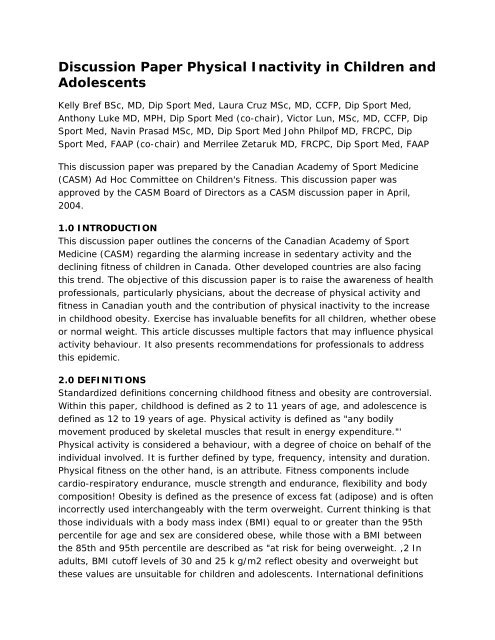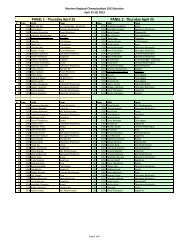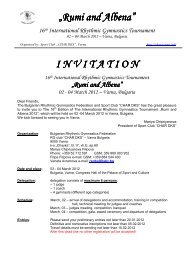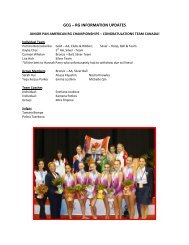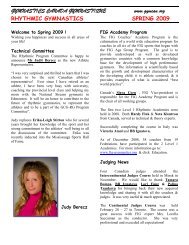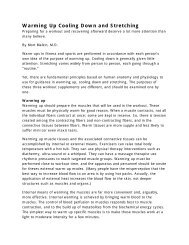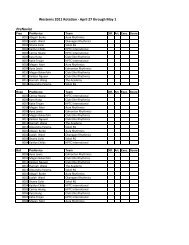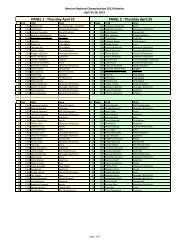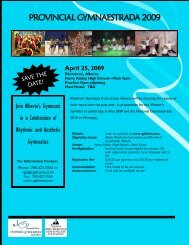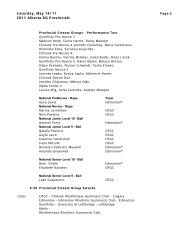Discussion Paper Physical Inactivity in Children and Adolescents
Discussion Paper Physical Inactivity in Children and Adolescents
Discussion Paper Physical Inactivity in Children and Adolescents
You also want an ePaper? Increase the reach of your titles
YUMPU automatically turns print PDFs into web optimized ePapers that Google loves.
<strong>Discussion</strong> <strong>Paper</strong> <strong>Physical</strong> <strong>Inactivity</strong> <strong>in</strong> <strong>Children</strong> <strong>and</strong><br />
<strong>Adolescents</strong><br />
Kelly Bref BSc, MD, Dip Sport Med, Laura Cruz MSc, MD, CCFP, Dip Sport Med,<br />
Anthony Luke MD, MPH, Dip Sport Med (co-chair), Victor Lun, MSc, MD, CCFP, Dip<br />
Sport Med, Nav<strong>in</strong> Prasad MSc, MD, Dip Sport Med John Philpof MD, FRCPC, Dip<br />
Sport Med, FAAP (co-chair) <strong>and</strong> Merrilee Zetaruk MD, FRCPC, Dip Sport Med, FAAP<br />
This discussion paper was prepared by the Canadian Academy of Sport Medic<strong>in</strong>e<br />
(CASM) Ad Hoc Committee on <strong>Children</strong>'s Fitness. This discussion paper was<br />
approved by the CASM Board of Directors as a CASM discussion paper <strong>in</strong> April,<br />
2004.<br />
1.0 INTRODUCTION<br />
This discussion paper outl<strong>in</strong>es the concerns of the Canadian Academy of Sport<br />
Medic<strong>in</strong>e (CASM) regard<strong>in</strong>g the alarm<strong>in</strong>g <strong>in</strong>crease <strong>in</strong> sedentary activity <strong>and</strong> the<br />
decl<strong>in</strong><strong>in</strong>g fitness of children <strong>in</strong> Canada. Other developed countries are also fac<strong>in</strong>g<br />
this trend. The objective of this discussion paper is to raise the awareness of health<br />
professionals, particularly physicians, about the decrease of physical activity <strong>and</strong><br />
fitness <strong>in</strong> Canadian youth <strong>and</strong> the contribution of physical <strong>in</strong>activity to the <strong>in</strong>crease<br />
<strong>in</strong> childhood obesity. Exercise has <strong>in</strong>valuable benefits for all children, whether obese<br />
or normal weight. This article discusses multiple factors that may <strong>in</strong>fluence physical<br />
activity behaviour. It also presents recommendations for professionals to address<br />
this epidemic.<br />
2.0 DEFINITIONS<br />
St<strong>and</strong>ardized def<strong>in</strong>itions concern<strong>in</strong>g childhood fitness <strong>and</strong> obesity are controversial.<br />
With<strong>in</strong> this paper, childhood is def<strong>in</strong>ed as 2 to 11 years of age, <strong>and</strong> adolescence is<br />
def<strong>in</strong>ed as 12 to 19 years of age. <strong>Physical</strong> activity is def<strong>in</strong>ed as "any bodily<br />
movement produced by skeletal muscles that result <strong>in</strong> energy expenditure."'<br />
<strong>Physical</strong> activity is considered a behaviour, with a degree of choice on behalf of the<br />
<strong>in</strong>dividual <strong>in</strong>volved. It is further def<strong>in</strong>ed by type, frequency, <strong>in</strong>tensity <strong>and</strong> duration.<br />
<strong>Physical</strong> fitness on the other h<strong>and</strong>, is an attribute. Fitness components <strong>in</strong>clude<br />
cardio-respiratory endurance, muscle strength <strong>and</strong> endurance, flexibility <strong>and</strong> body<br />
composition! Obesity is def<strong>in</strong>ed as the presence of excess fat (adipose) <strong>and</strong> is often<br />
<strong>in</strong>correctly used <strong>in</strong>terchangeably with the term overweight. Current th<strong>in</strong>k<strong>in</strong>g is that<br />
those <strong>in</strong>dividuals with a body mass <strong>in</strong>dex (BMI) equal to or greater than the 95th<br />
percentile for age <strong>and</strong> sex are considered obese, while those with a BMI between<br />
the 85th <strong>and</strong> 95th percentile are described as "at risk for be<strong>in</strong>g overweight. ,2 In<br />
adults, BMI cutoff levels of 30 <strong>and</strong> 25 k g/m2 reflect obesity <strong>and</strong> overweight but<br />
these values are unsuitable for children <strong>and</strong> adolescents. International def<strong>in</strong>itions
us<strong>in</strong>g pediatric BMI cutoffs based on pooled data have been proposed, however<br />
Canadian data was not <strong>in</strong>cluded.<br />
3.0 CHILDHOOD OBESITY<br />
The field of exercise science has shown tremendous growth, particularly <strong>in</strong> the<br />
areas of physical <strong>in</strong>activity <strong>and</strong> the <strong>in</strong>creas<strong>in</strong>g rates of childhood obesity. The field<br />
of exercise science has shown childhood obesity. A recent study by Tremblay <strong>and</strong><br />
Wilms provided strong evidence support<strong>in</strong>g an <strong>in</strong>crease <strong>in</strong> BMI <strong>in</strong> Canadian children.<br />
Us<strong>in</strong>g BMI obesity <strong>and</strong> overweight cut-off values from 1981, the number of obese<br />
children <strong>in</strong> Canada between the ages of 7 <strong>and</strong> 13 has <strong>in</strong>creased from 5% <strong>in</strong> both<br />
sexes <strong>in</strong> 1981 to 13.5% <strong>in</strong> boys <strong>and</strong> 11.8% <strong>in</strong> girls <strong>in</strong> 1996.4 The prevalence of<br />
children classified as overweight has <strong>in</strong>creased from 15% <strong>in</strong> 1981 to 28.8% for<br />
boys <strong>in</strong> 1996 (a 92% <strong>in</strong>crease) <strong>and</strong> from 15% to 23.6% for girls (a 57% <strong>in</strong>crease).<br />
Similar rates of obesity have been found <strong>in</strong> many <strong>in</strong>dustrialized nations <strong>in</strong>clud<strong>in</strong>g<br />
the United States5,6 <strong>and</strong> Australia. The National Center for Health Statistics (NCHS)<br />
has <strong>in</strong>dicated that more than 1 <strong>in</strong> 5 children <strong>and</strong> adolescents <strong>in</strong> the United States<br />
are overweight.5 Over the past several decades, obesity has <strong>in</strong>creased by 54% <strong>in</strong><br />
children 6 to 11 years old <strong>and</strong> 39% <strong>in</strong> adolescents 12 to 17 years old. Severe<br />
obesity has <strong>in</strong>creased by 98% <strong>in</strong> the younger group <strong>and</strong> by 64% <strong>in</strong> the adolescent<br />
age group.<br />
There is a concern that childhood obesity may lead to adult obesity, which is<br />
described as "track<strong>in</strong>g." Obese children are 5 to 7 times more likely to become<br />
obese adults than nonobese children.9 Research by Whitaker et al. 10 <strong>in</strong>dicated<br />
that children who were obese at age six had a 50% chance of becom<strong>in</strong>g obese as<br />
adults. Obese adolescents had a 70% to 80% probability of adult obesity. Several<br />
factors, <strong>in</strong>clud<strong>in</strong>g diet <strong>and</strong> activity level, contribute to the development of obesity.<br />
Activity level is the variable that appears the most amenable to change." The<br />
importance of address<strong>in</strong>g childhood obesity is paramount, s<strong>in</strong>ce several studies<br />
have l<strong>in</strong>ked it with an <strong>in</strong>creased risk of adult morbidity even when obesity has not<br />
persisted <strong>in</strong>to adulthood. 12 Also, the "heavy" economic burden of physical<br />
<strong>in</strong>activity translated to an estimated total direct cost of $2.1 billion to the Canadian<br />
health care system <strong>in</strong> 1999.13<br />
4.0 INCREASED SEDENTARY ACTIVITY<br />
It is reasonable to assume that the <strong>in</strong>crease <strong>in</strong> prevalence of obesity results from a<br />
comb<strong>in</strong>ation of <strong>in</strong>creased caloric <strong>in</strong>take <strong>and</strong> decreased physical activity. The<br />
importance of physical activity is often underestimated. Some evidence even<br />
suggests that obese children do not consume significantly more calories than nonobese<br />
children. 8,14 Overall fat consumption by the general population has also<br />
decreased <strong>in</strong> the general population. This suggests that physical <strong>in</strong>activity plays a
key role <strong>in</strong> the problem. 15 Total caloric <strong>in</strong>take has been positively associated with<br />
the number of hours of television view<strong>in</strong>g. Crespo et al. 16 observed that children<br />
who watch television more than 5 hours a day have significantly greater energy<br />
<strong>in</strong>take than those who watch less than one hour per day. Sedentary lifestyles lead<br />
to a susta<strong>in</strong>ed positive energy balance <strong>and</strong> are a major contribut<strong>in</strong>g factor to the<br />
development of obesity <strong>in</strong> children <strong>and</strong> adolescents. 17,18<br />
<strong>Children</strong> frequently choose to engage <strong>in</strong> sedentary activities over participation <strong>in</strong><br />
physical activities. Television view<strong>in</strong>g, video games, computers, Internet surf<strong>in</strong>g,<br />
<strong>and</strong> reduced physical education contribute to a reduction <strong>in</strong> physical activity.<br />
Canadian children ages 2 to 11 years watch an average of 15.5 hours of television<br />
per week, while teens ages 12 to 17 years watch an average of 14.1 hours of<br />
television per week. 19 A survey of 6 to 12 year old Canadian children showed<br />
almost 1 <strong>in</strong> 3 (36%) do not get the physical activity necessary for adequate<br />
development of cardiovascular fitness, muscle strength <strong>and</strong> flexibility.<br />
5.0 ADVERSE EFFECTS OF NON-EXERCISE<br />
It is well known that adult obesity has been associated with several chronic<br />
diseases <strong>in</strong>clud<strong>in</strong>g coronary artery disease, hypertension, osteoporosis, diabetes<br />
mellitus, lung disease, <strong>and</strong> some forms of cancer.21,22 These diseases are also<br />
becom<strong>in</strong>g a concern <strong>in</strong> obese children. Type 2 diabetes, once known as "adult<br />
onset," is a grow<strong>in</strong>g problem among children <strong>and</strong> adolescents, particularly among<br />
First Nations youth. Obesity <strong>and</strong> <strong>in</strong>activity contribute to <strong>in</strong>sul<strong>in</strong> resistance, the<br />
hallmark of type 2 diabetes. The fact that the rates of obesity, physical <strong>in</strong>activity<br />
<strong>and</strong> type 2 diabetes are <strong>in</strong>creas<strong>in</strong>g <strong>in</strong> children is concern<strong>in</strong>g.25,26 Exercise-<strong>in</strong>duced<br />
bronchospasm may be a limitation to physical activity. Obesity is associated with<br />
bronchial hyper-reactivity to exercise <strong>and</strong> may pre-dispose to asthma.<br />
6.0 IMPORTANCE OF EXERCISE AND PROPER NUTRITION<br />
Health benefits of regular physical activity <strong>in</strong>clude the ability to ma<strong>in</strong>ta<strong>in</strong> healthy<br />
bones <strong>and</strong> muscles, control weight <strong>and</strong> reduce fat, <strong>and</strong> decrease cardiovascular risk<br />
factors. Activities <strong>in</strong>volv<strong>in</strong>g repetitive cycles of load<strong>in</strong>g dur<strong>in</strong>g the first two decades<br />
of life before peak bone mass is usually achieved lead to adaptation by the bone ,2s<br />
which can have positive effects on bone density. This has the potential to reduce<br />
the risk of osteoporosis <strong>and</strong> fractures later <strong>in</strong> life, especially if the weight bear<strong>in</strong>g<br />
exercise is ma<strong>in</strong>ta<strong>in</strong>ed throughout adulthood .29 ,3o Exercise can also decrease the<br />
prevalence of hypertension.<br />
Exercise has been found to be beneficial <strong>in</strong> reduc<strong>in</strong>g adverse health issues <strong>in</strong> young<br />
people. There is an association between childhood obesity <strong>and</strong> low levels of<br />
selfesteem. 32 Regular physical activity can <strong>in</strong>crease self-esteem <strong>and</strong> may reduce
anxiety <strong>and</strong> stress <strong>in</strong> adolescents. 33 Students who participate <strong>in</strong> physical activity<br />
<strong>and</strong> sports are also less likely to be heavy smokers34 or use drugs35 <strong>and</strong> more<br />
likely to stay <strong>in</strong> school.36 Sports also <strong>in</strong>troduce young people to useful life skills<br />
such as teamwork, self-discipl<strong>in</strong>e, sportsmanship, leadership, <strong>and</strong> socialization. 37<br />
Given the potential effects on growth <strong>and</strong> development, proper nutrition is a critical<br />
aspect of health <strong>in</strong> children <strong>and</strong> adolescents. Unfortunately, there is cause for<br />
concern <strong>in</strong> the diet of Canadian youth. A cross-sectional survey compar<strong>in</strong>g 24-hour<br />
recall dietary <strong>in</strong>terviews of Canadians to "Canada's Food Guide to Healthy Liv<strong>in</strong>g,"<br />
showed that females age 13 to 17 had mean milk product <strong>and</strong> meat <strong>and</strong><br />
alternatives <strong>in</strong>take below the recommended m<strong>in</strong>imum level.38 The eat<strong>in</strong>g habits of<br />
grade six students <strong>in</strong> a 1998 Canadian survey revealed 73% ate at least one fruit a<br />
day, 45% ate at least one vegetable a day, 24% had chocolate or c<strong>and</strong>y daily <strong>and</strong><br />
15% ate potato chips or french fries daily.39 US studies4o,41 showed that of<br />
children between the ages of 7 <strong>and</strong> 14 years, only 46% met the recommended daily<br />
<strong>in</strong>take for gra<strong>in</strong>, 20% for vegetable, 5% for fruit, 9% for dairy, <strong>and</strong> 26% for meat.<br />
Moreover, a large proportion of total caloric <strong>in</strong>take came from fat <strong>and</strong> added sugar<br />
<strong>and</strong> accounted for 46% of the total calories.<br />
Excessive portion size can also lead to unnecessary calorie <strong>in</strong>take. Two other<br />
concern<strong>in</strong>g changes <strong>in</strong> eat<strong>in</strong>g habits of adolescents are an <strong>in</strong>creased <strong>in</strong>take of soft<br />
dr<strong>in</strong>ks <strong>and</strong> a decl<strong>in</strong>e <strong>in</strong> frequency of regular breakfast consumption. 39<br />
Consumption of juice, which has the approximate caloric <strong>in</strong>take of soft dr<strong>in</strong>ks,<br />
should also be considered as it may contribute a significant number of calories.<br />
<strong>Children</strong> <strong>and</strong> adolescents should eat a balanced diet with a range of calories <strong>and</strong><br />
nutrients appropriate for their levels of activity. They could, for example, follow<br />
suggestions <strong>in</strong> "The Canada Food Guide."<br />
7.0 HOW MUCH EXERCISE<br />
While agreement exists that sedentary activity <strong>in</strong>creases the likelihood of childhood<br />
obesity, 2 there is less consensus on the m<strong>in</strong>imal or optimal levels of activity <strong>in</strong><br />
children. Several recommendations have been published <strong>in</strong>clud<strong>in</strong>g "The<br />
International Consensus Conference on <strong>Physical</strong> Activity Guidel<strong>in</strong>es for <strong>Adolescents</strong>,<br />
,43 "The National Association for Sport <strong>and</strong> <strong>Physical</strong> Education"44 <strong>and</strong> "The<br />
Surgeon General Report.'°4s Most recommend that children <strong>and</strong> adolescents should<br />
be physically active every day or at least most days of the week. The suggested<br />
duration of activities ranged from 20 to 60 m<strong>in</strong>utes. <strong>Children</strong> <strong>and</strong> adolescents<br />
should be <strong>in</strong>volved <strong>in</strong> moderate to vigorous activities, or exertion sufficient to cause<br />
mild shortness of breath or sweat<strong>in</strong>g. Activities may be part of play, sports, work,<br />
transportation, physical education or planned exercise.
Health Canada has recognized the need for promot<strong>in</strong>g <strong>and</strong> improv<strong>in</strong>g physical<br />
activity as a key component of a healthy lifestyle. <strong>Physical</strong> activity guides are<br />
available for both children <strong>and</strong> adolescents. These guides were written <strong>in</strong><br />
conjunction with specialists from the Canadian Society for Exercise Physiology, the<br />
Canadian Paediatric Society <strong>and</strong> the College of Family Physicians of Canada.<br />
"Canada's <strong>Physical</strong> Activity Guides for <strong>Children</strong> <strong>and</strong> Youth"<br />
(www.healthcanada.ca/paguide) are based on the assumption that most of<br />
Canada's young people are <strong>in</strong>sufficiently active. These guides recommend a<br />
30m<strong>in</strong>ute <strong>in</strong>crement of activity beyond the level currently practiced by the<br />
child/adolescent. To make time for added activity, "The Guides" recommend a<br />
concomitant reduction of 30 m<strong>in</strong>utes per day of "screen time" (TV, computer,<br />
video). The goal is to gradually <strong>in</strong>crease the daily physical activity of youth to 90<br />
m<strong>in</strong>utes over a period of months.<br />
8.0 WHAT EXTERNAL INFLUENCES AFFECT PHYSICAL ACTIVITY<br />
Lifestyle behaviours may be determ<strong>in</strong>ed early <strong>in</strong> life. Parents, peers, health<br />
professionals <strong>and</strong> school significantly <strong>in</strong>fluence youth. Socioeconomic factors,<br />
media, government <strong>and</strong> sport<strong>in</strong>g organizations also play a role <strong>in</strong> determ<strong>in</strong><strong>in</strong>g<br />
participation <strong>in</strong> exercise activities.<br />
8.1 Adult <strong>in</strong>fluences<br />
Adults are important role models for children <strong>in</strong> dietary <strong>and</strong> physical activity<br />
practises.47,48 Childhood is a critical time for children to seek approval from<br />
adults. Parents should set appropriate examples for healthy behaviours. Short- <strong>and</strong><br />
long-term success <strong>in</strong> behavioural <strong>in</strong>tervention has been demonstrated when at least<br />
one parent is an active participant.49 Compliance with exercise <strong>and</strong> diet <strong>in</strong>crease<br />
when children observe similar behaviours <strong>in</strong> their parens.50 Dur<strong>in</strong>g childhood <strong>and</strong><br />
adolescence, risk factors for becom<strong>in</strong>g overweight51 <strong>in</strong>clude: overweight parent(s);<br />
low <strong>in</strong>come family situation, chronic disease or disability that restricts movement,<br />
<strong>and</strong> certa<strong>in</strong> ethnic/racial groups, such as First Nations' people.<br />
Coaches also have major <strong>in</strong>fluences on young athletes. Coaches should have proper<br />
tra<strong>in</strong><strong>in</strong>g <strong>and</strong> help promote a healthy, fun environment for sports, <strong>in</strong>clud<strong>in</strong>g healthy<br />
competition, skill development, <strong>and</strong> safety. Coaches can also provide advice on<br />
fitness <strong>and</strong> nutrition. The Coach<strong>in</strong>g Association of Canada certification has become<br />
a leader <strong>in</strong> st<strong>and</strong>ardiz<strong>in</strong>g qualifications. Tra<strong>in</strong><strong>in</strong>g programs, volunteer<strong>in</strong>g screen<strong>in</strong>g<br />
or reference checks help provide education for coaches. This translates to coaches<br />
teach<strong>in</strong>g healthy behaviors as well as sports skills.<br />
8.2 Peers<br />
As children progress <strong>in</strong>to adolescence, the <strong>in</strong>fluence of peers beg<strong>in</strong>s to become a
compet<strong>in</strong>g factor with parental <strong>in</strong>fluence <strong>in</strong> determ<strong>in</strong><strong>in</strong>g behaviour. Widespread<br />
decl<strong>in</strong>e <strong>in</strong> physical activity among groups of young people is a major concern. In<br />
general, boys tend to participate <strong>in</strong> greater numbers <strong>and</strong> exercise more <strong>in</strong>tensively<br />
than girls. 52 Participation <strong>in</strong> activities tend to peak by age 10 to 13 (92%).50<br />
Information from "The Government of Canada National Population Survey" showed<br />
that both sexes experience a decrease <strong>in</strong> physical activity as they mature, <strong>and</strong> the<br />
decl<strong>in</strong>e is greater for girls. 53 Therefore, adolescent girls are a group of particular<br />
concern for decl<strong>in</strong><strong>in</strong>g physical activity.<br />
Analysis of the 1990 Ontario Health Survey revealed a major decl<strong>in</strong>e <strong>in</strong> physical<br />
activity between the ages of 13 <strong>and</strong> 19 especially <strong>in</strong> females, which resulted <strong>in</strong> an<br />
<strong>in</strong>crease of physical <strong>in</strong>activity from 22% to 60% .54 Twenty-seven per cent of girls<br />
ages 12 to 14 were <strong>in</strong>active which <strong>in</strong>creased to 48% by ages 15 to 19. In<br />
comparison, twenty-one percent of 12 to 14 year old boys were found to be<br />
physically <strong>in</strong>active, which <strong>in</strong>creased to 28% <strong>in</strong> males ages 15 to 19. A review of<br />
n<strong>in</strong>e other studies by Sallis revealed a consistent decl<strong>in</strong>e <strong>in</strong> physical activity seen<br />
over the school-age years with the mean level of physical activity decreas<strong>in</strong>g about<br />
2.7% per year <strong>in</strong> males <strong>and</strong> about 7.4% per year <strong>in</strong> females. 52 The pressures of<br />
adolescence often distract young people from participat<strong>in</strong>g <strong>in</strong> physical activity. A<br />
movement toward keep<strong>in</strong>g young people active through promotion, education <strong>and</strong><br />
opportunities for activity needs to be a priority.<br />
8.3 School<br />
The decreas<strong>in</strong>g trend of physical activity dur<strong>in</strong>g leisure time is mirrored <strong>in</strong> the<br />
participation <strong>and</strong> requirements of physical education <strong>in</strong> schools. The Canadian<br />
Association for Health, <strong>Physical</strong> Education, Recreation <strong>and</strong> Dance (CAHPERD)<br />
recommended that all Canadian children ages 5 to 18 participate <strong>in</strong> 150 m<strong>in</strong>utes of<br />
school-based physical education per week. 5 CAHPERD estimated that schools are<br />
averag<strong>in</strong>g only 60 m<strong>in</strong>utes of physical education per week. Ontario high school<br />
students are required to complete only one course <strong>in</strong> physical education <strong>and</strong> many<br />
of them have met this requirement by age 14 or 15.56 Regional disparity <strong>in</strong> the<br />
amount of physical activity provided exists between <strong>and</strong> with<strong>in</strong> prov<strong>in</strong>ces <strong>and</strong><br />
territories. Increased quality of life is a benefit of regular physical activity <strong>in</strong> specific<br />
populations such as children with special health care needs. The stark contrast<br />
between the optional status of physical education <strong>and</strong> the m<strong>and</strong>atory nature of<br />
academic subjects may give a mixed message of the importance of exercise <strong>and</strong><br />
could lessen students', teachers', <strong>and</strong> schools' perceived value of it.<br />
<strong>Physical</strong> education is necessary to give students the opportunity to ga<strong>in</strong> the<br />
knowledge <strong>and</strong> the skills to adopt active lifestyles. These translate <strong>in</strong>to <strong>in</strong>creased<br />
physical competence, health-related fitness, self-esteem <strong>and</strong> enjoyment. 57
<strong>Physical</strong> education curricula <strong>in</strong> schools should focus on promot<strong>in</strong>g <strong>in</strong>dividual<br />
activities of moderate to vigorous <strong>in</strong>tensity, which can be transferred outside the<br />
school sett<strong>in</strong>g, rather than only to team or organized sports. 58<br />
School, by its nature of hav<strong>in</strong>g a captive audience, is an ideal situation to <strong>in</strong>fluence<br />
children. Schools should offer quality, daily physical education, recess for<br />
unstructured play, extracurricular programs <strong>and</strong> appropriate classroom health<br />
education. Together, these elements provide knowledge <strong>and</strong> skills to ma<strong>in</strong>ta<strong>in</strong> an<br />
active lifestyle.59 The United States has made it a priority to <strong>in</strong>crease the amount<br />
of participation <strong>and</strong> class time <strong>in</strong>volv<strong>in</strong>g physical activity. 60 School-based physical<br />
education programs have been strongly recommended as an effective <strong>in</strong>tervention<br />
for improv<strong>in</strong>g physical activity, particularly <strong>in</strong> elementary schools. 61,62,63<br />
8.4 Primary care physicians<br />
Three recent reviews of r<strong>and</strong>omized controlled trials (RCT) exam<strong>in</strong>ed the<br />
effectiveness of activity promotion counsel<strong>in</strong>g by primary care physicians on activity<br />
levels. 64,65,66 One of the RCT studies was performed <strong>in</strong> Canada. The support for<br />
counsel<strong>in</strong>g varied among the three reviews. Further research, <strong>in</strong>clud<strong>in</strong>g long term<br />
studies, needs to be performed to assess the effectiveness of counsel<strong>in</strong>g, especially<br />
for children. Nevertheless, physicians have a responsibility to obta<strong>in</strong> <strong>in</strong>formation<br />
<strong>and</strong> educate patients to promote physical activity.<br />
Brief counsel<strong>in</strong>g <strong>in</strong>terventions by primary care physicians are effective <strong>in</strong> improv<strong>in</strong>g<br />
selfreported physical activity levels <strong>in</strong> adults <strong>in</strong> the short term. 68 However, only<br />
36% to 48% of physicians counsel to promote physical activity. 69,70 Physicians<br />
identified <strong>in</strong>adequate time, knowledge, <strong>and</strong> experience as barriers to counsel<strong>in</strong>g. 71<br />
Suggestions to improve patient compliance <strong>in</strong>clude: focused visits on physical<br />
activity counsel<strong>in</strong>g; tailored <strong>in</strong>terventions <strong>and</strong> written materials; <strong>and</strong> use of a<br />
variety of health care team members.<br />
Physicians can take the <strong>in</strong>itiative to review age-specific recommendations for<br />
patients <strong>and</strong> parents. Written exercise prescriptions us<strong>in</strong>g st<strong>and</strong>ardized pads of<br />
<strong>in</strong>structions or written h<strong>and</strong>outs <strong>in</strong>crease compliance. A separate counsel<strong>in</strong>g session<br />
focused exclusively on exercise is more beneficial than deal<strong>in</strong>g with physical activity<br />
dur<strong>in</strong>g the course of a regular visit for multiple health issues. F<strong>in</strong>ally, encourag<strong>in</strong>g<br />
the <strong>in</strong>dividual to exercise <strong>in</strong> a group or with a parent or partner was found more<br />
effective <strong>in</strong> <strong>in</strong>creas<strong>in</strong>g physical activity.<br />
Education of parents <strong>and</strong> family is also extremely important s<strong>in</strong>ce adults <strong>and</strong><br />
sibl<strong>in</strong>gs can act as physically active role models, plan family activities for the<br />
children which <strong>in</strong>clude physical activity, facilitate participation of children <strong>in</strong> sports
programs, <strong>and</strong> advocate for quality school <strong>and</strong> community physical activity<br />
programs. 73 Physicians can help publicize <strong>and</strong> dissem<strong>in</strong>ate tools such as "Canada's<br />
<strong>Physical</strong> Activity Guides to Healthy Liv<strong>in</strong>g" to raise awareness of the benefits <strong>and</strong><br />
methods of <strong>in</strong>creas<strong>in</strong>g physical activity. Physicians have a responsibility to the<br />
community which they serve, <strong>and</strong> advocat<strong>in</strong>g for safe access to facilities for<br />
physical activities is another way to be proactive.<br />
8.5 Societal factors<br />
Considerations must be made to the accessibility of facilities, the distribution of<br />
facilities, <strong>and</strong> the resources <strong>and</strong> programs for physical activities. This is important<br />
particularly for low <strong>in</strong>come communities. Data <strong>in</strong> "The National Longitud<strong>in</strong>al Survey<br />
of <strong>Children</strong> <strong>and</strong> Youth" (NLSCY) <strong>in</strong> 1999 showed that children <strong>in</strong> lower <strong>in</strong>come<br />
families with very young parents or s<strong>in</strong>gle parents, or whose primary caregiver had<br />
less than a high school education, were least likely to participate <strong>in</strong> organized<br />
activities. 74 Adequate organization, fund<strong>in</strong>g, supervision <strong>and</strong> equipment are all<br />
essential. Municipal, prov<strong>in</strong>cial <strong>and</strong> federal governments should ensure that<br />
community physical activity facilities are easily accessible <strong>and</strong> safe .72 Community<br />
programs can mix non-competitive <strong>and</strong> competitive activities <strong>in</strong> addition to offer<strong>in</strong>g<br />
a variety of developmentally appropriate <strong>and</strong> socially enjoyable activities<br />
throughout many age ranges. The government should take a centralized role <strong>in</strong><br />
improv<strong>in</strong>g the consistency of availability of services <strong>and</strong> fund<strong>in</strong>g to communities.<br />
The media play an important role through their major <strong>in</strong>fluence on youth today.<br />
Foodrelated television commercials have <strong>in</strong>fluential effects on children's dietary<br />
preferences <strong>and</strong> eat<strong>in</strong>g habits. 75 Advertisements that promote sedentary activities<br />
like video games, <strong>and</strong> that downplay the benefits of physical activities, can have an<br />
<strong>in</strong>sidious health effect. Media can <strong>in</strong>stead use its powerful <strong>in</strong>fluence to raise<br />
awareness by promot<strong>in</strong>g physical activity messages <strong>in</strong> community-wide campaigns<br />
<strong>and</strong> advertis<strong>in</strong>g local community physical activity events.<br />
9.0 SUMMARY<br />
Multi-factorial issues <strong>in</strong>volv<strong>in</strong>g physical activity <strong>and</strong> exercise promotion determ<strong>in</strong>e<br />
the level of childhood fitness. It is important that organizations such as Health<br />
Canada, the Canadian Academy of Sport Medic<strong>in</strong>e, the Canadian Society for<br />
Exercise Physiology, the Canadian Paediatric Society, <strong>and</strong> the Canadian College of<br />
Family Physicians, cont<strong>in</strong>ue to advance the movement of improv<strong>in</strong>g physical activity<br />
<strong>and</strong> fitness <strong>in</strong> children <strong>and</strong> youth. A concerted effort must be organized from the<br />
grass-roots level with participation from community groups, schools, health<br />
professionals, media, private corporations, <strong>and</strong> government. These groups play a<br />
pivotal role <strong>in</strong> provid<strong>in</strong>g access <strong>and</strong> opportunities for physical activities for Canadian<br />
children.
10.0 REFERENCES<br />
1. Casperson CJ, Powell KE, Christenson GM. <strong>Physical</strong> activity, exercise, <strong>and</strong><br />
physical fitness: def<strong>in</strong>itions <strong>and</strong> dist<strong>in</strong>ctions for health-related research.<br />
Public Health Rep 1985; 100:126-31.<br />
2. Barlow SE, Dietz WH. Obesity evaluation <strong>and</strong> treatment: Expert committee<br />
recommendations. 1998;102(3) Available at:<br />
http://www.pediatrics.org/cgi/content/full/I02/3/e29. Accessed May 2004.<br />
3. Cole TJ, Bellizzi MC, Flegal KM, Dietz WH. Establish<strong>in</strong>g a st<strong>and</strong>ard def<strong>in</strong>ition<br />
for child overweight <strong>and</strong> obesity worldwide: <strong>in</strong>ternational survey. BMJ<br />
2000;320:1-6.<br />
4. Tremblay MS., Wilms JD. Secular trends <strong>in</strong> the body mass <strong>in</strong>dex of Canadian<br />
children. CMAJ 2000;163 (11):1429-3 3.<br />
5. Troiano RP, Flegal KM. Overweight children <strong>and</strong> adolescents: description,<br />
epidemiology, <strong>and</strong> demographics. Pediatrics 1998;101:497-505.<br />
6. Gortmaker SL, Dietz WH, Sobol AM, Wehler CA. Increas<strong>in</strong>g pediatric obesity<br />
<strong>in</strong> the United States. Am J Dis Child 1987;141:535-40.<br />
7. Dollman J, Olds T, Norton K, Stuart D. The evolution of fitness <strong>and</strong> fatness <strong>in</strong><br />
10-11 year old Australian schoolchildren: changes <strong>in</strong> distributional<br />
characteristics between 1985 <strong>and</strong> 1997. Pediatr Exer Sci 1999;11:108-21.<br />
8. Moran R. Evaluation <strong>and</strong> treatment of childhood obesity. Am Fam Physician.<br />
1999;59:861-8, 871-3.<br />
9. Schmitz MKH, Jeffrey RW. Public health <strong>in</strong>terventions for the prevention <strong>and</strong><br />
treatment of obesity. Med Cl<strong>in</strong> North Am 2000; 84:491-512.<br />
10.Whitaker RC, Wright JA, Pepe MS, Seidel KD, Dietz WH. Predict<strong>in</strong>g obesity <strong>in</strong><br />
young adulthood from childhood <strong>and</strong> parental obesity. N Engl J Med<br />
1997;337:869-73.<br />
11.Dietz WH, B<strong>and</strong><strong>in</strong>i LG, Gortmaker S. Epidemiologic <strong>and</strong> metabolic risk factors<br />
for childhood obesity. Prepared for the Fourth Congress on Obesity Research,<br />
Vienna, Austria, December 1988. Kl<strong>in</strong> Padiatr 1990;202:69-72.<br />
12.Must A, Jacques PF, Dallal GE, et al. Long-term morbidity <strong>and</strong> mortality of<br />
overweight adolescents. A follow-up of the Harvard Growth Study of 1922 to<br />
1935. N Engl J Med 1992;327:1350-5.<br />
13.Katzmarzyk PT, Gledhill N, Shephard RJ. The economic burden of physical<br />
<strong>in</strong>activity <strong>in</strong> Canada. Can Med Assoc J, 2000; 163:1435-40.
14.Nicklas TA, Webber LS, Sr<strong>in</strong>ivasan SR, Berenson GS. Secular trends <strong>in</strong><br />
dietary <strong>in</strong>takes <strong>and</strong> cardiovascular risk factors <strong>in</strong> 10-year-old children: the<br />
Bogalusa Heart Study (1973-1988). Am J Cl<strong>in</strong> Nutr 1993;57:930-7.<br />
15.Bar-Or O, Foreyt J, Bouchard C et al. <strong>Physical</strong> activity, genetic, <strong>and</strong><br />
nutritional considerations <strong>in</strong> childhood weight management. Med Sci Sports<br />
Exerc 1998;30:2-10.<br />
16.Crespo CJ, Smit E, Troiano RP, Bartlett SJ, Macera CA, Anderson RE.<br />
Television Watch<strong>in</strong>g Energy Intake, <strong>and</strong> Obesity <strong>in</strong> US <strong>Children</strong>. Arch Pediatr<br />
Adolesc Med 2001; 155:360-5.<br />
17.Garcia, A., Pender N., Antonakos, C., Ronis, D. Changes <strong>in</strong> physical activity<br />
beliefs <strong>and</strong> behaviors of boys <strong>and</strong> girls across the transition to junior high<br />
school. J Adolesc Health 1998;22:394-402.<br />
18.Anderson RE., Crespo CJ., Bartlett SJ., Chesk<strong>in</strong> LJ., Pratt M. Relationship of<br />
physical activity <strong>and</strong> television watch<strong>in</strong>g with body weight <strong>and</strong> level of<br />
fatness among children: results of the Third National Health <strong>and</strong> Nutrition<br />
Exam<strong>in</strong>ation Survey. JAMA 1998;279:938-42.<br />
19.Statistics Canada. Average hrs/week of television view<strong>in</strong>g (2000). Data table.<br />
20.Heart <strong>and</strong> Stroke Foundation. Report Card on the Health of Canada's Kids:<br />
March 2, 1998. Available at: http://wwl.heart<strong>and</strong>stroke.ca. Accessed April 9,<br />
2003.<br />
21.Gortmaker SL, Must A, Perr<strong>in</strong> JM, Sobol AM, Dietz WH. Social <strong>and</strong> economic<br />
consequences of overweight <strong>in</strong> adolescence <strong>and</strong> young adulthood. N Engl J<br />
Med 1993;329:1008-12.<br />
22.Lyznicki JM, Young DC, Riggs JA, Davis RM. Obesity: assessment <strong>and</strong><br />
management <strong>in</strong> primary care. Am Fam Physician 2001;63:2185-96.<br />
23.Advisory Committee on Healthy Active Liv<strong>in</strong>g for <strong>Children</strong> <strong>and</strong> Youth,<br />
Canadian Paediatric Society. Healthy active liv<strong>in</strong>g for children <strong>and</strong> youth.<br />
Paediatr Child Health, 2002;7(5):339-45.<br />
24.Harris SB, Perk<strong>in</strong>s BA, Whalen-Bough E. Non-<strong>in</strong>sul<strong>in</strong>-dependent diabetes<br />
mellitus among First Nations children. New entity among First Nation people<br />
of Northwestern Ontario. Can Fam Physician 1996;42:869-76.<br />
25.American Diabetes Association. Type 2 diabetes <strong>in</strong> children <strong>and</strong> adolescents.<br />
Pediatrics 2000;105:671-80.<br />
26.American Diabetes Association: Type 2 diabetes <strong>in</strong> children <strong>and</strong> adolescents.<br />
Diabetes Care 2000;23:381.
27.Kaplan TA, Montana E. Exercise-<strong>in</strong>duced bronchospasm <strong>in</strong> nonasthmatic<br />
obese children. Cl<strong>in</strong> Pediatr 1993;32:220-5.<br />
28.Marcus R. Role of exercise <strong>in</strong> prevent<strong>in</strong>g <strong>and</strong> treat<strong>in</strong>g osteoporosis. Rheum<br />
Dis Cl<strong>in</strong> North Am 2001;27:131-41.<br />
29.Riddoch C, Boreham C. <strong>Physical</strong> activity, physical fitness <strong>and</strong> children's<br />
health: current concepts. In: Armstrong N, van Mechelen W, eds. Pediatric<br />
Exercise Science <strong>and</strong> Medic<strong>in</strong>e. Oxford: Oxford University Press, 2000:243-<br />
52.<br />
30.Kesaniemi YA, Danforth E Jr, et al. Dose-response issues concern<strong>in</strong>g physical<br />
activity <strong>and</strong> health: an evidence-based symposium. MSSE 2001;33:6, S351-<br />
8.<br />
31.Hansen HA, Froberg K, Hylder<strong>and</strong>t N, Nielsen JR. A controlled study of eight<br />
months of physical tra<strong>in</strong><strong>in</strong>g <strong>and</strong> reduction of blood pressure <strong>in</strong> children: The<br />
Odense schoolchild study. BMJ 1991;303:682-5.<br />
32.Strauss RS. Childhood obesity <strong>and</strong> self-esteem. Pediatrics 2000;105:e15.<br />
33.Farmer ME, Locke BZ, Mocicki EK, Dannenberg AL, Larson DB, Radloff LS.<br />
<strong>Physical</strong> activity <strong>and</strong> depressive symptoms: the NHANES I Epidemiologic<br />
Follow-up Study. Am J Epidemiol 1988;128(6):1340-51.<br />
34.K<strong>in</strong>o-Qu6bec, 2000, <strong>Physical</strong> Activity, a Determ<strong>in</strong>ant of Health <strong>in</strong> Youth:<br />
Advisory Op<strong>in</strong>ion of the K<strong>in</strong>o-Qu6bec Scientific Committee, Secretariat au<br />
loisir et au sport, m<strong>in</strong>istere de la Sante et des Services sociaux,<br />
Gouvernement du Qu6bec, 24 pages<br />
35.Escobedo LG, Marcus SE, Holtzman D, Giov<strong>in</strong>o GA. Sports participation, age<br />
at smok<strong>in</strong>g <strong>in</strong>itiation <strong>and</strong> the risk of smok<strong>in</strong>g among US high school students.<br />
JAMA 1993;269:1391-5.<br />
36.Zill N, Nord CW, Loomis LS. Adolescent time use, risky behavior <strong>and</strong><br />
outcomes: an analysis of national data. Rockville, MD: Westat, 1995.<br />
37.Cahill, B.R. <strong>and</strong> Pearl, A.J. (Eds.), Intensive Participation <strong>in</strong> <strong>Children</strong>'s Sports,<br />
Human K<strong>in</strong>etics Publishers, Champaign, Ill<strong>in</strong>ois, 1993.<br />
38.Starkey LJ, Johnson-Down L, Gray-Donald K. Food habits of Canadians:<br />
comparison of <strong>in</strong>takes <strong>in</strong> adults <strong>and</strong> adolescents to Canada's food guide to<br />
healthy eat<strong>in</strong>g..Can J Diet Pract Res 2001;62(2):61-9.<br />
39.K<strong>in</strong>g, A, Boyce, WF, <strong>and</strong> K<strong>in</strong>g, MA. Trends <strong>in</strong> the Health of Canadian Youth.<br />
Health Canada, 1999.
40.Brady LM, L<strong>in</strong>dquist CH, Herd SL, Goran MI. Comparison of <strong>Children</strong>'s Dietary<br />
Intake Patterns with US Dietary Guidel<strong>in</strong>es. Brit J Nutr 2000;84:361-7.<br />
41.Munoz KA, Krebs-Smith SM, Ballard-Barbash R, Clevel<strong>and</strong> LE. Food Intakes<br />
of US <strong>Children</strong> <strong>and</strong> <strong>Adolescents</strong> Compared with Recommendations. Pediatrics,<br />
1997;100(3, Pt 1):323-9.<br />
42.Berkowitz RI, Agras WS, Korner AF, Kraemer HC, Zeanah CH. <strong>Physical</strong><br />
activity <strong>and</strong> adiposity: a longitud<strong>in</strong>al study from birth to childhood. J Pediatr<br />
1985;106:734-8.<br />
43.Sallis JF, Patrick K. <strong>Physical</strong> activity guidel<strong>in</strong>es for adolescents: consensus<br />
statement. Pediatr Exercise Sci 1994;6:302-14.<br />
44.Corb<strong>in</strong> CB, Pangrazi RP. <strong>Physical</strong> activity for children: a statement of<br />
guidel<strong>in</strong>es. Reston, VA: National Association for Sport <strong>and</strong> <strong>Physical</strong> Education,<br />
1998.<br />
45.US Department of Health <strong>and</strong> Human Services: <strong>Physical</strong> Activity <strong>and</strong> Health:<br />
A Report of the Surgeon General. Atlanta, DHHS, Centers for Disease Control<br />
<strong>and</strong> Prevention, National Center for Chronic Disease Prevention <strong>and</strong> Health<br />
Promotion, 1996.<br />
46.Advisory Committee on Healthy Active Liv<strong>in</strong>g for <strong>Children</strong> <strong>and</strong> Youth,<br />
Canadian Paediatric Society. Healthy active liv<strong>in</strong>g for children <strong>and</strong> youth.<br />
Paediatr Child Health, 2002;7:5:339-45.<br />
47.Krebs NF, Johnson SL. Guidel<strong>in</strong>es for healthy children: Promot<strong>in</strong>g eat<strong>in</strong>g,<br />
mov<strong>in</strong>g, <strong>and</strong> common sense. J Am Diet Assoc 2000;100(1): 37-9.<br />
48.Whitaker et al. Predict<strong>in</strong>g obesity <strong>in</strong> Young Adulthood from childhood <strong>and</strong><br />
parental obesity. NEJM 1997;337(13):870 (Session 13).<br />
49.Epste<strong>in</strong> LH. Family-based behavioural <strong>in</strong>tervention for obese children. Int J<br />
Obes Relat Metab Disord. 1996;20(suppll):S14-21.<br />
50.Hunter L, Grenier S, Br<strong>in</strong>k S. Statistics Canada: National Longitud<strong>in</strong>al Survey<br />
of children <strong>and</strong> youth: Participation <strong>in</strong> activities. December 1, 2001. Available<br />
at http://www.ophea.net. Accessed August 2002.<br />
51.Troiano RP, Flegal KM. Overweight children <strong>and</strong> <strong>Adolescents</strong>: Description,<br />
Epidemiology, <strong>and</strong> demographics. Pediatrics 1998;101(3, Part 2):497-504.<br />
52.Sallis J. Epidemiology of physical activity <strong>and</strong> fitness <strong>in</strong> children <strong>and</strong><br />
adolescents. Crit Rev Food Sci 1993;33:403-8.<br />
53.Statistics Canada. <strong>Physical</strong> activity, by age group <strong>and</strong> sex, household<br />
population aged 12 <strong>and</strong> over (1998). Data table.
54.Allison K. Predictors of <strong>Inactivity</strong>: An Analysis of the Ontario Health Survey.<br />
Can J Public Health 1996;87:354-8.<br />
55.Canadian Association of Health, <strong>Physical</strong> Education <strong>and</strong> Recreation. Quality<br />
daily physical education rationale h<strong>and</strong>book. Ottawa: The Association; 1987.<br />
56.Allision K, Adlaf E. Age <strong>and</strong> Sex Differences <strong>in</strong> <strong>Physical</strong> <strong>Inactivity</strong> Among<br />
Ontario Teenagers. Can J Public Health 1997;88(3):177-80.<br />
57.National St<strong>and</strong>ards for physical education. ERIC Clear<strong>in</strong>ghouse on teach<strong>in</strong>g<br />
<strong>and</strong> teacher education. Available at: http://www.ed.gov/databases/ERIC<br />
Digests/ed406361.htm1. Accessed November, 2001.<br />
58.Faucette N, Sallis J, McKenzie T, Alcaraz J, Kolody B, Nugent P. Comparsion<br />
of fourth grade students' out-of-school physical activity levels <strong>and</strong> choices by<br />
gender: Project SPARK. J Health Educ 1995;26: Supplement 82-90.<br />
59.Department of Health <strong>and</strong> Human Services. Promot<strong>in</strong>g better health for<br />
young people through physical activity <strong>and</strong> sports. December, 2000; p.16.<br />
Available at: http://www.cdc.gov/nccdphp/dash/presphysactrpt). Accessed<br />
August 2002.<br />
60.Centers for Disease Control <strong>and</strong> Prevention. Guidel<strong>in</strong>es for school <strong>and</strong><br />
community programs to promote lifelong physical activity among young<br />
people. Morb Mortal Weekly Rep 1997;46(RR-6):1-36.<br />
61.Task Force on Community Preventive Services. Increas<strong>in</strong>g physical activity: A<br />
report on recommendations of the task force on community preventive<br />
services. MMWR 2001;50(RR18):1-16.<br />
62.Gortmaker SL, Cheung LW, Peterson KE et al. Impact of a school-based<br />
<strong>in</strong>terdiscipl<strong>in</strong>ary <strong>in</strong>tervention on diet <strong>and</strong> physical activity among urban<br />
primary school children: eat well <strong>and</strong> keep mov<strong>in</strong>g. Arch Pediatr Adolesc Med<br />
1999;153:9:975-83.<br />
63.Gortmaker SL, Peterson K, Wiecha J, Sobol AM, Dixit S, Fox MK, Laird N.<br />
Reduc<strong>in</strong>g obesity via a school-based <strong>in</strong>terdiscipl<strong>in</strong>ary <strong>in</strong>tervention among<br />
youth: Planet Health. Arch Pediatr Adolesc Med 1999;153:4:409-18.<br />
64.Petrella RJ, Lattanzio CN. Does counsell<strong>in</strong>g help patients get active<br />
Systematic review of the literature. Can Fam Physician 2002;48:72-80.<br />
65.Eak<strong>in</strong> EG, Glasgow RE, Riley KM. Review of primary care-based physical<br />
activity <strong>in</strong>tervention studies. J Fam Pract 2000;49:158-68.<br />
66.Eaton CB, Menard LM. A systematic review of physical activity promotion <strong>in</strong><br />
primary care office sett<strong>in</strong>gs. Br J Sports Med 1998;32:11-6.
67.Petrella RJ, Wight D. An office-based <strong>in</strong>strument for exercise counsell<strong>in</strong>g <strong>and</strong><br />
prescription <strong>in</strong> primary care: The Step Test Exercise Prescription (STEP). Arch<br />
Fam Med 2000;9:339-44.<br />
68.Eak<strong>in</strong> EG, Glasgow RE, Riley KM. Review of primary care-based physical<br />
activity <strong>in</strong>tervention studies. J Fam Pract 2000; 49:2:158-68.<br />
69.Damush TM et al. Prevalence <strong>and</strong> correlates of physician recommendations to<br />
older adults to exercise. Ann Behav Med 1998;20:S194.<br />
70.Eak<strong>in</strong> EG, Glasgow RE. Recruitment of managed care Medicare patients for a<br />
physical activity study. Am J Health Promot 1997;12:98.<br />
71.Abramson S, Ste<strong>in</strong> J, Schaufele M, Frates E, Rogan S. Personal exercise<br />
habits <strong>and</strong> counsell<strong>in</strong>g practices of primary care physicians: A national<br />
survey. Cl<strong>in</strong> J Sport Med 2000;10:40-8.<br />
72.Task Force on Community Preventive Services. Increas<strong>in</strong>g physical activity: A<br />
report on recommendations of the task force on community preventive<br />
services. MMWR 2001;50(RR18);1-16.<br />
73.Department of Health <strong>and</strong> Human Services. Promot<strong>in</strong>g better health for<br />
young people through physical activity <strong>and</strong> sports. December 2000; p.15.<br />
Available at: http://www.cdc.gov/nccdphp/dash/presphysactrpt. Accessed<br />
August 2002.<br />
74.Hunter L, Grenier S, Br<strong>in</strong>k S. Statistics Canada: National Longitud<strong>in</strong>al Survey<br />
of children <strong>and</strong> youth: Participation <strong>in</strong> activities. December 1, 2001. Available<br />
at http://www.ophea.net. Accessed August 2002.<br />
75.Taras, HL, Sallis, JF, Patterson, TL, Nader, PR, <strong>and</strong> Nelson, JA. Television's<br />
<strong>in</strong>fluence on children's diet <strong>and</strong> physical activity. J Dev Behav Pediatr<br />
1989;10(4):176-80.<br />
__________________________________________________________________<br />
____________<br />
Title<br />
Publisher<br />
<strong>Discussion</strong> paper: physical <strong>in</strong>activity <strong>in</strong> children<br />
<strong>and</strong> adolescents.<br />
Canadian Academy of Sport Medic<strong>in</strong>e<br />
SIRC Article # S-972436


